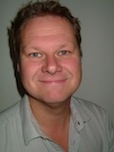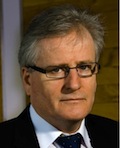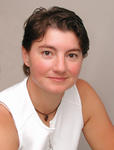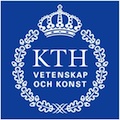Keynote Speakers
We are very pleased to have acquired the services of an excellent selection of keynote speakers for SEB'12. It is our aspiration that these speakers will give our delegates a view about technological and scientific activities, relating to sustainability in energy and buildings, taking place in various areas of the world.
The speakers and the titles of their talks are shown below.
Professor Göran Finnveden
KTH Royal Institute of Technology, SwedenSustainability Challenges for the Building Sector
More details ...
Professor Per Heiselberg
Aalborg University, DenmarkBuildings - both part of the problem and the solution!
More details ...
Professor Gudni Johannesson
Icelandic National Energy Authority, IcelandMeeting the challenges of climatic change - the hard way or the clever way
More details ...
Professor Lynne A. Slivovsky
California Polytechnic State University, USAThe Questions That Keep Me Up At Night
More details ...
Professor Göran Finnveden
KTH Royal Institute of Technology, SwedenSustainability Challenges for the Building Sector
Abstract:
The building and real estate management sector is responsible for a significant part of the environmental impacts of our society. The sector's contribution to the threat of climate change for production of heat and electricity for the buildings are of special importance. It is important to consider the full life-cycle of buildings and also consider production and transportation of building materials, construction and waste management. In Sweden, emissions of gases contributing to climate change from heating of buildings have decreased during the last decades as results of strong policy instruments. One the other hand emissions from other parts of the life-cycle of buildings have increased, illustrating the need to have a wide systems perspective in order to avoid sub-optimizations. It is also important to consider other environmental threats such as the use of hazardous chemicals, air quality, generation of waste and impacts on ecosystems from production of building materials as well as on building sites.
The building sector has a large potential to reduce its environmental footprint. Many of the most cost-efficient possibilities for mitigation of climate change are related to the building sector. Governmental policies are important for changes to be made. Voluntary instruments such as building rating tools may have an additional role. The ICT-sector may have one of its largest potentials in contributing to a more sustainable society in the building sector. Because of the long life-time of buildings, we are now constructing the future environmental impacts. When looking for cost-efficient solutions, we must therefore also consider the future cost-efficiency. In the presentation also social aspects of sustainability will be discussed including possibilities for the building sector to contribute to a better health and reduced health inequalities.

Biography:
Göran Finnveden is Professor in Environmental Strategic Analysis and Vice-President for sustainable development at KTH Royal Institute of Technology, Stockholm, Sweden. He is a M.Sc. in Chemical Engineering 1989, PhD in Natural Resources Management, Associate Professor in Industrial Ecology 2003 and full Professor 2007. His research has focused on environmental systems analysis tools such as Life Cycle Assessment, Strategic Environmental Assessment and Input-Output Analysis. It has included both methodological development and case studies. Application areas include buildings, energy systems, information and communication technologies, infrastructure and waste management. He has also worked with environmental policy in areas such as environmental policy integration, integrated product policy and waste policy. He is a currently a member of the Scientific Advisory Council to the Swedish Minister of the Environment, an expert in the governmental commission on waste management and a member of the board of directors of the Swedish Waste Nuclear Fund. According to Scopus he has published more than 60 scientific papers and is cited nearly 2000 times.
Professor Per Heiselberg
Aalborg University, DenmarkBuildings - both part of the problem and the solution!
Abstract:
Energy use for room heating, cooling and ventilation accounts for more than one-third of the total, primary energy demand in the industrialized countries, and is in this way a major polluter of the environment. At the same time the building sector is identified as providing the largest potential for CO2 reduction in the future and many countries across the world have set very ambitious targets for energy efficiency improvements in new and existing buildings. For example at European level the short term goal has recently been expressed in the recast of the EU Building Performance Directive as "near zero energy buildings" by 2020.
To successfully achieve such a target it is necessary to identify and develop innovative integrated building and energy technologies, which facilitates considerable energy savings and the implementation and integration of renewable energy devices within the built environment. The rapid development in materials science, information and sensor technology offers at the same time considerable opportunities for development of new intelligent building components and systems with multiple functions.
Such a development will impose major challenges on the building industry as building design will completely change from design of individual components and systems to integrated design of systems and concepts involving design teams of both architects, engineers and other experts. Future system and concepts solutions will require that building components must beable fulfill multiple performance criteria and often contradictory requirements from aesthetics, durability, energy use, health and comfort. A key example of this is building facades that instead of the existing static performance characteristics must develop into dynamic solutions with the ability to dynamically adjust physical properties and energetic performance in response to fluctuations in the outdoor environment and changing needs of the occupants in order to fulfill the future targets for energy use and comfort. Buildings will also be both consumers and producers of energy which creates a number of new challenges for building design like identification of the optimum balance between energy savings and renewable energy production. The interaction between the energy "prosuming" building and the energy supply grid will also be an important issue to solve.
The lecture will address and illustrate these future challenges for the building sector and give directions for solutions.

Biography:
Per Heiselberg is Professor at the Department of Civil Engineering at Aalborg University, Denmark. He holds a M.Sc. and a Ph.D. in Indoor Environmental Engineering.
His research and teaching subjects are within architectural engineering and are focused on the following topics:
- Energy-efficient building design (Net zero energy buildings, design of low energy buildings - integration of architectural and technical issues, modelling of double skin facades, night cooling of buildings and utilization of thermal mass, multifunctional facades, daylight in buildings, passive energy technologies for buildings, modeling of building energy use and indoor environment)
- Ventilation and air flow in buildings (Modelling and measurements of air and contaminants flows (both gas- and particles) in buildings, ventilation effectiveness, efficient ventilation of large enclosures, numerical simulation (computational fluid dynamics) of air and contaminant flows as well as modeling of natural and hybrid ventilation)
Currently, Per Heiselberg is leading the national strategic research centre on Net Zero Energy Buildings in Denmark (www.zeb.aau.dk). The centre has a multidisciplinary research approach and a close cooperation with leading Danish companies.
He has been involved in many EU and IEA research projects in the past 20 years. He was the operating agent of IEA-ECBCS Annex 35 (1997-2002) and IEA-ECBCS Annex 44 (2005-2009), (www.ecbcs.org). Presently he is involved in ECBCS Annexes 52, 53 and 59. Contact
Aalborg University
Department of Civil Engineering
Sohngaardsholmsvej 57, DK-9000 Aalborg, Denmark
Phone +45 9940 8541
E-mail: ph@civil.aau.dk
Homepage: www.aau.dk
Professor Gudni Johannesson
Icelandic National Energy Authority, IcelandMeeting the challenges of climatic change - the hard way or the clever way
Abstract:
We may not agree on how the possible CO2 driven scenarios of climate change in the future may look like but we all can agree that the anthropogenic increase in CO2 levels in the world atmosphere exposes humanity to higher risks of changes in the environment than we want to face in our, our children's or their children's lifetime.
It is evident that we are now facing a global challenge that we are more often dealing with by local solutions. Our guiding rule is that by saving energy we are also mitigating greenhouse gas emission. Also if we are using renewable energy and substituting fossil fuels we are also moving in the right direction. There are however important system aspects that we should be considering.
The first one if we are using the right quality of energy for the right purpose. A common example is when high quality energy such as electricity or gas is used directly to provide domestic hot water or heat houses instead of using heat pumps or cogeneration processes to get the highest possible ratio between the used energy and the primary energy input.
The second one is if we are obstructing necessary structural changes that could lead to a more effective energy system globally. We have big reserves of cost effective renewable energy sources, hydropower and geothermal energy around the world that are far from the markets and would therefore need relocation structural changes in our industrial production system to be utilized.
The third aspect is if we are using our investments in energy conversion and energy savings in the best way to meet our climatic goals or if we are directed by other hidden agendas to such a degree that a large part of our economical input is wasted.
It is evident that the national and local strategies for energy savings are closely linked to other strategic areas such as industrial development, household economy, mobility. Also a necessary precondition for investment is that the nations maintain their economic strength and their ability to develop their renewable resources and to invest in new more efficient processes.
The key to success in mitigating the climatic change is therefor to create a holistic strategy that beside the development of technical solutions for energy efficiency and utilization of renewable energy also considers the local and global system aspects. With present technologies for energy efficient solutions, proper energy quality management r and with utilization of cost effective renewable energy sources we have all possibilities to reduce energy related the global CO2 emissions to acceptable levels.

Biography:
Born in Reykjavik 1951. He finished his MSc in Engineering physics in 1976, his PhD thesis on thermal models for buildings in 1981 and was appointed as an associate professor at Lund University in 1982. He was awarded the title of doctor honoris causae from the University of Debrecen in 2008 and the Swedish Concrete Award in 2011. From 1975 he worked as a research assistant at Lund University, from 1982 as a consultant in research and building physics in Reykjavik and from 1990 as a professor in Building Technology at KTH in Stockholm and from 2008 an affiliated professor at KTH. His research has mainly concerned the thermodynamical studies of buildings, innovative building systems and energy conservation in the built environment. Since the beginning of 2008 he is the Director General of the Icelandic National Energy Authority which is responsible for public administration of energy research, energy utilization and regulation. He was a member of the The Hydropower Sustainability Assessment Forum processing the Hydropower Sustainability Assessment Protocol adopted by IHA in November 2010 and presently the chair of IPGT the International Partnership for Geothermal Technologies.
Professor Lynne A. Slivovsky
California Polytechnic State University, USAThe Questions That Keep Me Up At Night
Abstract:
This keynote will provide an opportunity for reflection on the work we do. We're here talking about energy and sustainability but we're also talking about a different way of living. We, as a technical field, a society, a world, are on a path of profound technological development. What does it mean to educate someone to contribute to this world? To have a technical education? What does it mean to live in this world? And is it possible that we as designers, innovators, engineers, and scientists can consider these questions in our day-to-day work?

Biography:
Lynne A. Slivovsky (Ph.D., Purdue University, 2001) is Associate Professor of Electrical and Computer Engineering at California Polytechnic State University, San Luis Obispo, California, USA. In 2003 she received the Frontiers In Education New Faculty Fellow Award. Her work in service-learning led to her selection in 2007 as a California Campus Compact-Carnegie Foundation for the Advancement of Teaching Faculty Fellow for Service-Learning for Political Engagement. In 2010 she received the Cal Poly President's Community Service Award for Significant Faculty Contribution. She currently oversees two multidisciplinary service-learning programs: the Access by Design Project that has capstone students designing recreational devices for people with disabilities and the Organic Twittering Project that merges social media with sustainability. Her work examines design learning in the context of engagement and the interdependence between technology and society.
ContactLynne A. Slivovsky, Ph.D.
Associate Professor
Electrical and Computer Engineering
California Polytechnic State University
1 Grand Avenue
San Luis Obispo, CA 93407 USA
E-mail: lslivovs@calpoly.edu








